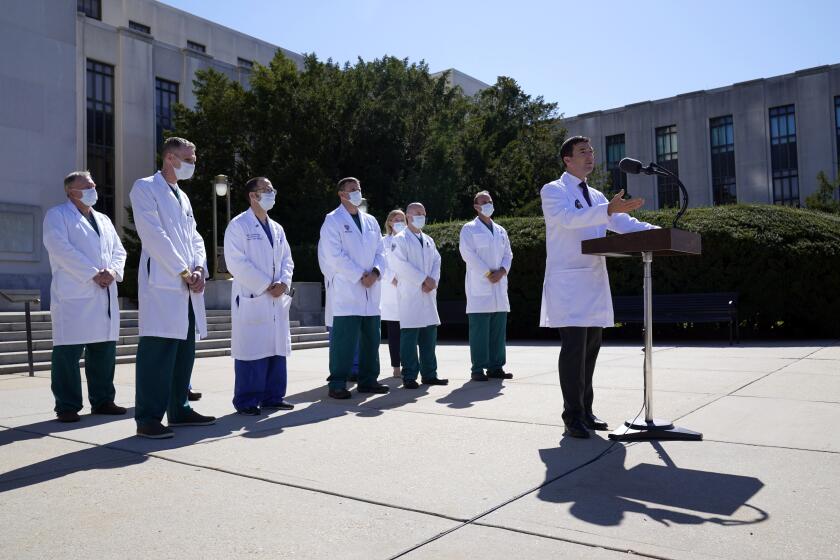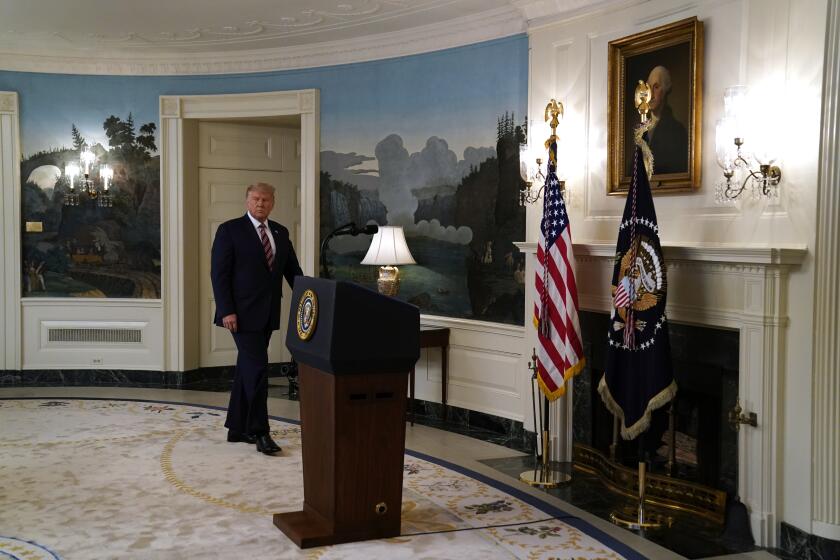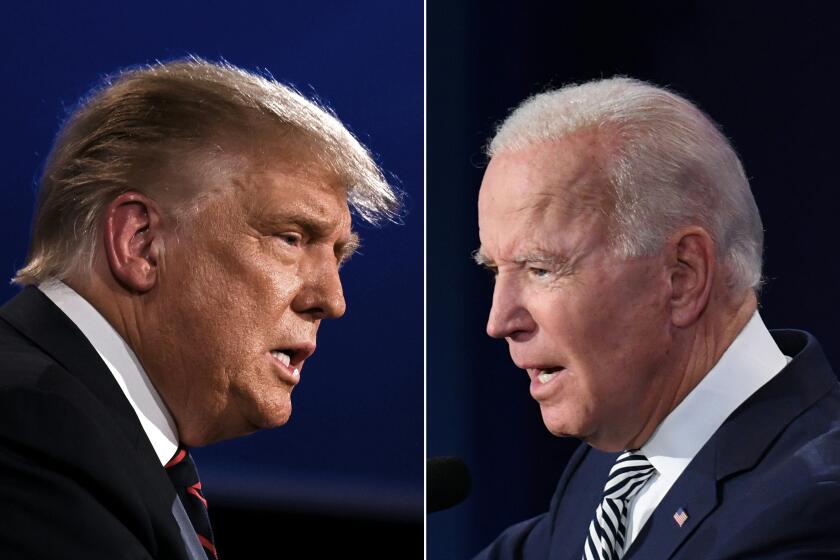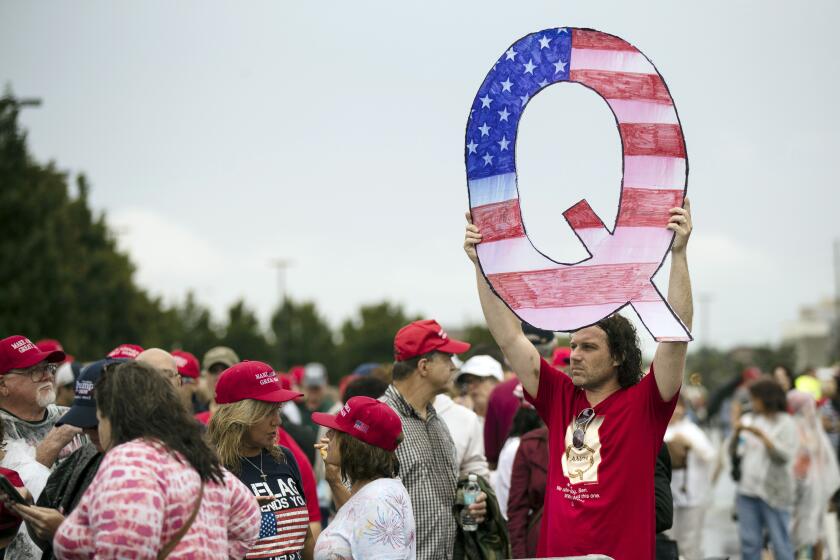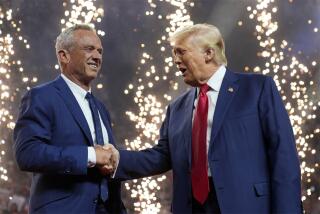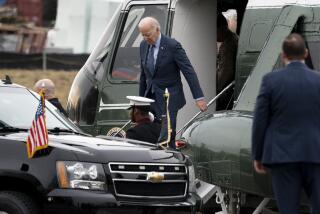Secrets and lies: U.S. presidential medical history is full of them
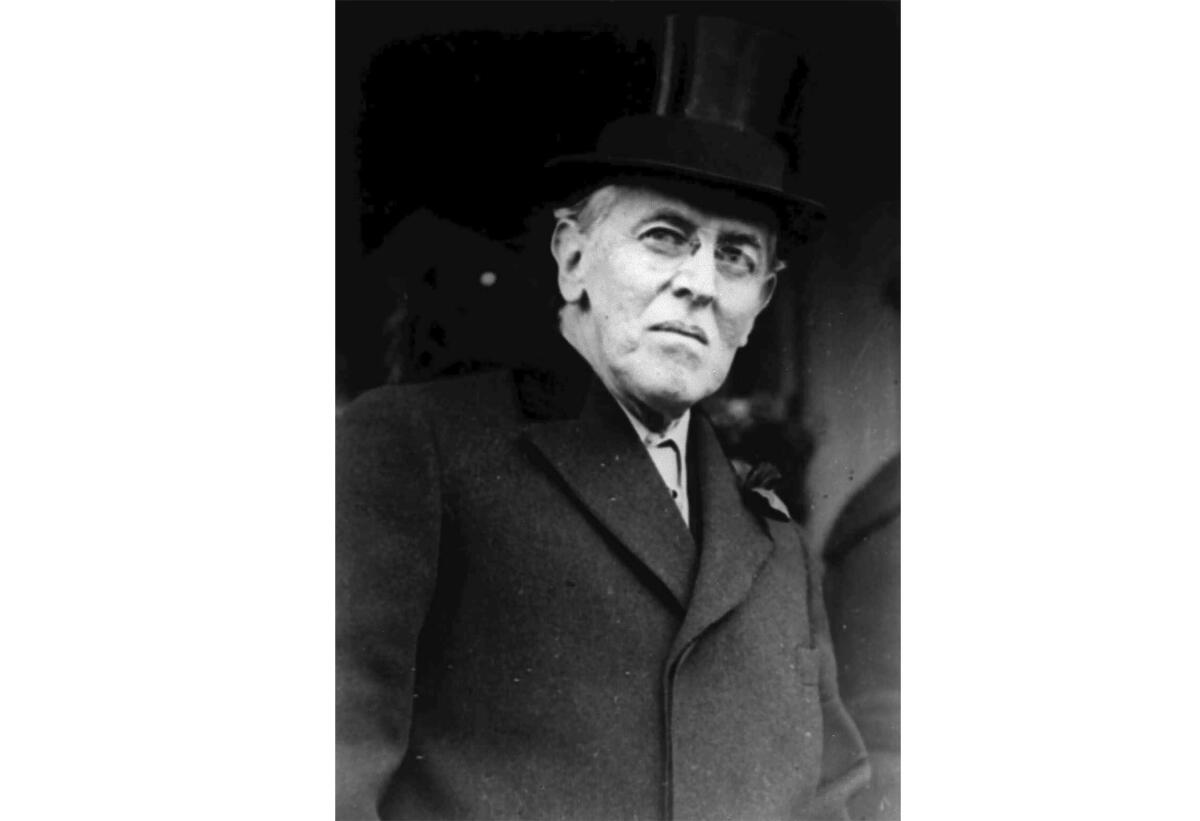
- Share via
WASHINGTON — Throughout American history, an uncomfortable truth has been evident: Presidents have lied about their health.
In some cases, the issues were minor, in others quite grave. Sometimes it took decades for the public to learn the truth.
Now President Trump has been diagnosed with COVID-19. The White House initially said he had “mild symptoms,” but by Friday evening he was admitted to Walter Reed National Military Medical Center. After a rosy news conference by the president’s medical team, White House chief of staff Mark Meadows said Saturday that Trump had gone through a “very concerning” period Friday and that the next 48 hours would be critical in terms of his care. Trump has also received stronger treatments than a mild case of COVID-19 would seem to warrant.
Pandemics have cursed the presidencies of both Trump and Woodrow Wilson. Each played down the viruses that killed hundreds of thousands of Americans. Both presidents got sick — and each had to decide how much to tell the public.
Like many previous administrations, Wilson’s White House tried to keep his sickness secret.
He was at talks in Paris on ending World War I when he fell ill in April 1919. His symptoms were so severe and surfaced so suddenly that his personal physician, Cary Grayson, thought he had been poisoned. After a fitful night caring for Wilson, Grayson wrote a letter back to Washington to inform the White House that the president was very sick.
Officials try to allay fears about Trump’s condition, but contradictory information and a credibility gap undermine the effort.
Flash forward 100 years. In a tweet at 12:54 a.m. Friday, Trump told the world that he and First Lady Melania Trump had contracted COVID-19.
The White House initially shared few details about his condition. White House Press Secretary Kayleigh McEnany said he was taken to Walter Reed many hours later “out of an abundance of caution.”
However sick he was or wasn’t, his illness was startling since Trump had been declaring almost daily that the nation had turned the corner on the coronavirus, which has led to the deaths of 208,000 people in the United States.
Trump has acknowledged playing down the pandemic so as not to create panic, but there were political reasons for doing so. Seeking another four years in office, Trump did not want the U.S. economy to tank before the Nov. 3 election.
A new Bob Woodward book says President Trump said he knew the coronavirus was deadly even as he insisted in public it posed no danger.
“The Wilson administration, for a very different reason, completely downplayed the [Spanish flu] pandemic,” said John Barry, an adjunct professor in public health at Tulane University whose book “The Great Influenza” chronicles the 1918-19 pandemic that sickened Wilson and killed 675,000 Americans. “Wilson was concerned that any negative news about anything would detract from the war effort — decrease the energy that people would put into winning the war. In this case, there are more strictly political benefits.”
William Howell, professor of American politics at the University of Chicago, wonders how transparent the White House will be about Trump’s case of COVID-19.
“He is obviously going to be eager to get back onto the campaign trail,” Howell said. “He has all kinds of incentives to signal strength and to get back into the mix.”
But, Howell added, “this is a president who’s been less than straightforward over the course of his presidency about all manner of factual issues. And so, is he to be believed is a good cause of real concern.”
He said the pathology of COVID-19 and the virus in 1918 are “very similar, and that’s a little scary.”
After mocking Biden for wearing a mask, the president is diagnosed with COVID-19. The pandemic is back in full focus.
History is replete with examples of how presidents have kept the American public in the dark about their ailments and medical conditions.
Grover Cleveland, fearing poor health would be a political weakness, underwent secret oral surgery late at night in a private yacht in Long Island Sound. The cancerous lesion taken from his mouth was displayed in 2000 in an exhibit by the College of Physicians, a Philadelphia-based medical society.
Lyndon B. Johnson secretly underwent surgery for removal of a skin lesion on his hand in 1967.
After leading the nation through a decade of war and depression, Franklin D. Roosevelt was diagnosed early in 1944 as suffering from high blood pressure, hypertensive heart disease, cardiac failure and acute bronchitis.
The problems also betrayed an underlying arteriosclerosis, a hardening of the arteries. Roosevelt was put on a low-salt diet and ordered to cut down on smoking. But with an election coming up, Roosevelt and the White House staff issued a statement saying the problem was far less serious.
“The stories that he’s in bad health are understandable enough around election time, but they are not true,” his doctor told a reporter. Historians now believe his doctors concealed all the facts from their patient and the public.
Roosevelt won reelection. Months later, on April 12, 1945, he died of a stroke.
According to historian Robert Dallek, John F. Kennedy suffered more pain and illness than most people knew and took as many as eight medications a day, including painkillers, stimulants, sleeping pills and hormones to keep him alive. Dallek, who wrote a biography of Kennedy, examined medical files from the last eight years of Kennedy’s life, up to his assassination.
Kennedy was known for having a bad back, and since his death, biographers have pieced together details of other illnesses, including persistent digestive problems and Addison’s disease, a life-threatening lack of adrenal function. Kennedy went to great lengths to conceal his ailments, even denying to reporters that he had Addison’s disease.
Dwight D. Eisenhower had a serious heart attack in 1955 while vacationing in Colorado. He was hospitalized for six weeks. Instead of advising Eisenhower not to run for a second term, his doctor recommended that more time in office would aid his recovery.
In 1841, William Henry Harrison became ill with what doctors thought was pneumonia caused by cold weather during his inauguration, where he rode on horseback without a topcoat. The White House did not tell the public that Harrison was sick. Harrison died just nine days after becoming ill and only one month after taking the oath of office.
After Trump’s COVID-19 news, QAnon adherents were baselessly claiming it was all part of a conspiracy plan, forcing online platforms to react.
After pools of reporters began to cover nearly every moment that a president is in public, it became harder for U.S. commanders-in-chief to keep their medical conditions private.
The first known instance of a so-called pool reporter inside the White House was in 1881, when James A. Garfield was shot. As Garfield lay in bed, Associated Press reporter Franklin Trusdell sat outside the president’s sickroom, listening to him breathe and sharing updates with other correspondents.
“I listen for every sound,” Trusdell wrote to his wife in a note about his overnight vigil at the White House. “A dog barking in the distance is heard. A fountain splashes on the lawn. Not a step is heard in the mansion. The president sleeps.”
More to Read
Get the L.A. Times Politics newsletter
Deeply reported insights into legislation, politics and policy from Sacramento, Washington and beyond. In your inbox three times per week.
You may occasionally receive promotional content from the Los Angeles Times.
